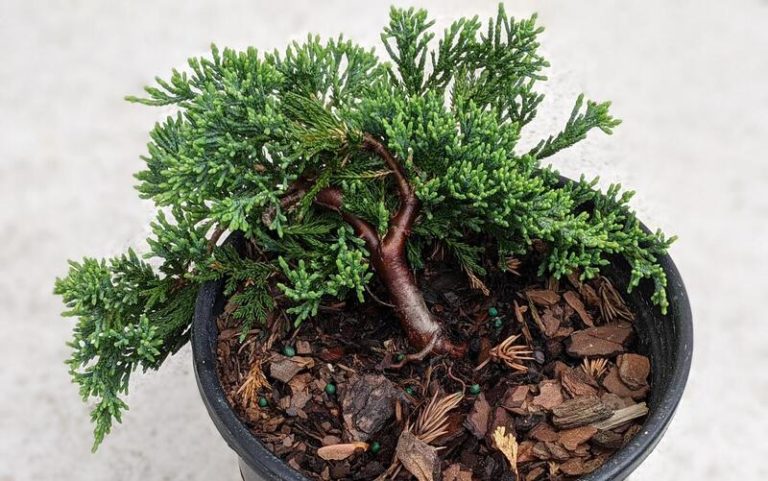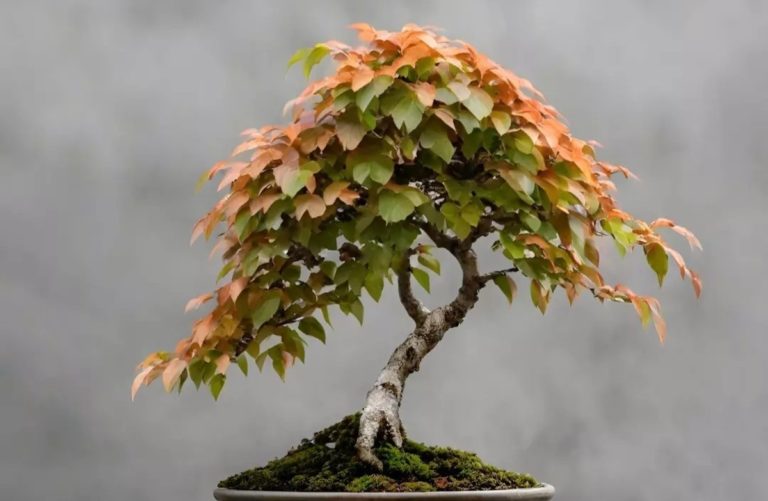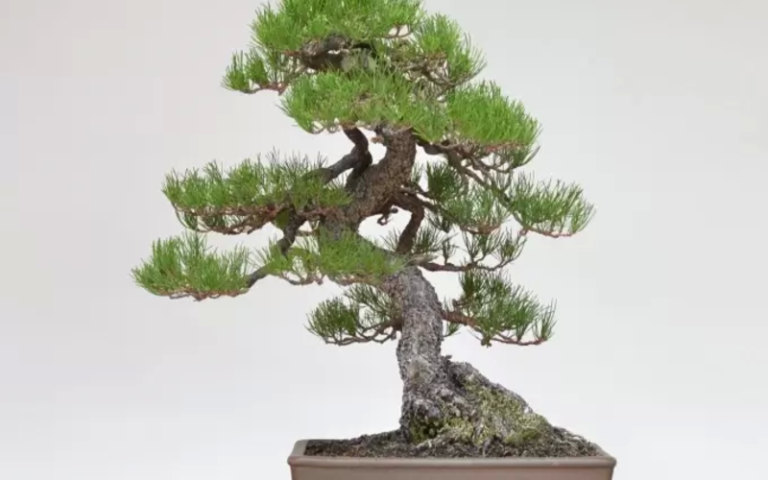Sabina Juniper Bonsai: Crafting Serenity and Beauty in a Pot
Bonsai is a captivating art form that involves growing miniature trees in containers. One popular bonsai variety is the Sabina Juniper. In this article, we will explore the history, characteristics, and step-by-step guidelines for growing and maintaining a Sabina Juniper bonsai.
What is a Sabina Juniper Bonsai?
Sabina Juniper Bonsai, scientifically known as Juniperus sabina, is a popular variety of bonsai tree. It is a miniature version of the Sabina Juniper, a coniferous evergreen tree native to Asia, particularly the mountainous regions. Sabina Juniper Bonsai is highly regarded for its unique characteristics and aesthetic appeal.
History and Origins of Sabina Juniper Bonsai
The history and origins of Sabina Juniper Bonsai can be traced back to the rugged mountainous regions of Asia, particularly in areas such as China, Mongolia, and Siberia. The Sabina Juniper (Juniperus sabina) species itself has a long-standing presence in these regions, and its use in bonsai cultivation has been practiced for centuries.
The art form of bonsai began in ancient China, where trees were nurtured and trimmed to resemble the forms of bigger, mature trees seen in nature. Bonsai art soon migrated to Japan, where it became profoundly rooted in the culture and was developed through time.
The Sabina Juniper, with its hardy nature and unique growth patterns, caught the attention of bonsai enthusiasts and became a favored choice for bonsai cultivation. The trees’ ability to withstand harsh climates and adapt to various environmental conditions made them well-suited for bonsai artistry.
Sabina Juniper Bonsai embodies the principles of bonsai aesthetics, emphasizing balance, harmony, and a sense of natural beauty within a small-scale tree. The gnarled trunks, twisted branches, and delicate foliage of the Sabina Juniper lend themselves well to the art of shaping and pruning, allowing bonsai artists to create miniature representations of majestic, weathered trees.
Over time, the cultivation and appreciation of Sabina Juniper Bonsai spread across the globe, reaching bonsai enthusiasts from different cultures and regions. Today, Sabina Juniper Bonsai continues to be cherished for its historical significance, captivating appearance, and the sense of tranquility it brings to bonsai gardens and collections worldwide.
Sabina Juniper Bonsai and Their Symbolism
Sabina Juniper Bonsai carries symbolism that is deeply rooted in the art of bonsai and the cultural significance of the tree itself. Here are some symbolic associations attributed to Sabina Juniper Bonsai:
Sabina Juniper Bonsai is well-known for its capacity to tolerate severe weather and difficult growth circumstances. Its twisted trunks and gnarled branches represent tenacity, fortitude, and resilience in the face of adversity. This strength reminds us to be strong and resilient in the face of life’s adversities.
Age and Wisdom: The aged appearance of Sabina Juniper Bonsai, with its weathered trunks and branches, evokes a sense of wisdom and longevity. The tree’s ability to endure and grow gracefully over time is symbolic of the wisdom and experience gained through the passage of years.
Balance and Harmony: Bonsai, including Sabina Juniper Bonsai, emphasizes the concept of balance and harmony. The careful pruning and shaping of the tree to create a balanced and visually pleasing composition symbolizes the pursuit of balance and harmony in life. It serves as a reminder to seek equilibrium and serenity amidst the complexities of existence.
Connection to Nature: Bonsai is a method to incorporate a piece of nature into our homes. Juniper Sabina’s Bonsai symbolizes our connection to nature and the necessity of caring for and maintaining the environment. It reminds us of our position as stewards of nature and the need of appreciating and protecting the beauty and peace it provides.
Patience and Contemplation: Bonsai cultivation, including Sabina Juniper Bonsai, requires patience and dedication. The slow and deliberate process of shaping and training the tree teaches us the value of patience and the rewards of contemplation. It encourages us to slow down, be present in the moment, and appreciate the beauty that unfolds over time.
It’s important to note that symbolism can vary across different cultures and personal interpretations. Sabina Juniper Bonsai may hold additional or different symbolic meanings for individuals based on their cultural backgrounds, personal experiences, and beliefs. Ultimately, the symbolism of Sabina Juniper Bonsai is deeply personal and can be appreciated in a way that resonates with each individual bonsai enthusiast.
Characteristics of the Sabina Juniper Bonsai
The Sabina Juniper Bonsai (Juniperus sabina) possesses several unique characteristics that make it a favored choice among bonsai enthusiasts. Here are some notable features of the Sabina Juniper Bonsai:
1. Twisted Trunks and Branches: The Sabina Juniper Bonsai is known for its twisted and contorted trunks and branches. This characteristic gives the tree an aged and weathered appearance, adding depth and visual interest to the overall composition.
2. Delicate Foliage: The foliage of the Sabina Juniper Bonsai consists of small, scale-like leaves. The leaves are typically green or bluish-green in color, adding a touch of vibrancy to the tree’s appearance.
3. Compact Growth Pattern: Sabina Juniper Bonsai has a compact growth habit, making it suitable for bonsai cultivation. Its branches tend to grow closer to the trunk, allowing for intricate shaping and pruning techniques to create desirable bonsai styles.
4. Irregular and Gnarled Branches: The branches of Sabina Juniper Bonsai often exhibit irregular and gnarled growth patterns, contributing to its unique and captivating aesthetic. These twisted branches further enhance the tree’s aged and natural appearance.
5. Resilience: Sabina Juniper Bonsai is renowned for its adaptability and ability to flourish in a variety of climates. It can withstand colder temperatures and acclimate to varying environmental conditions, making it a suitable option for bonsai devotees in a variety of regions.
6. Evergreen Nature: As an evergreen tree, the Sabina Juniper Bonsai retains its foliage year-round. This quality adds to its appeal as a bonsai, providing a touch of greenery and liveliness even during the winter months.
7. Natural Deadwood and Bark Texture: Some Sabina Juniper Bonsai specimens may display natural deadwood, which refers to areas of exposed, weathered wood. This feature adds character and authenticity to the bonsai, resembling the effects of aging and weathering in nature. The bark of the Sabina Juniper is often textured and furrowed, contributing to the tree’s overall charm.
These unique characteristics make the Sabina Juniper Bonsai a captivating choice for bonsai enthusiasts. Its twisted trunks, delicate foliage, compact growth pattern, and resilience reflect the beauty and harmony found in nature, bringing a sense of tranquility and elegance to any bonsai collection.
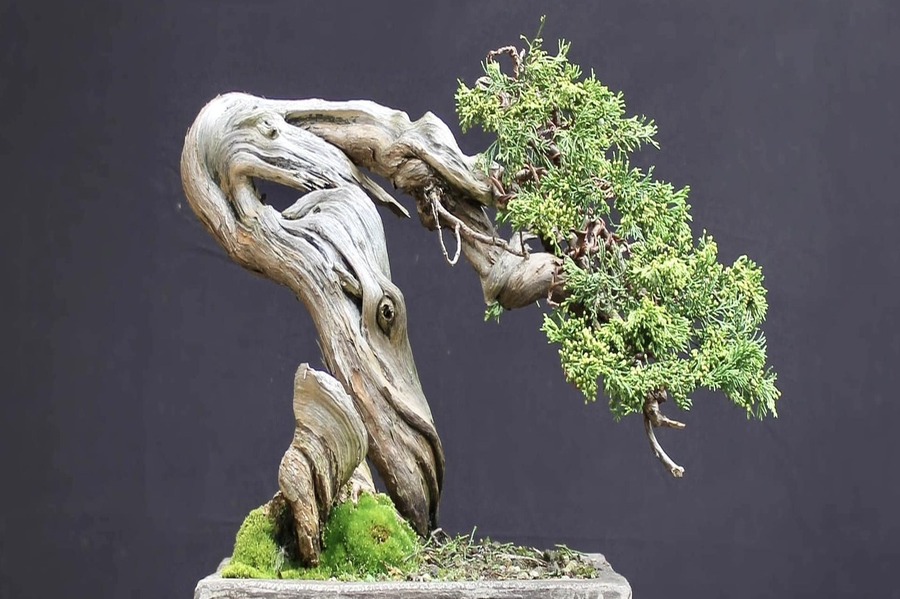
Types of Sabina Juniper Bonsai
There are several recognized types or varieties of Sabina Juniper Bonsai, each with its own unique characteristics. Here are a few notable types of Sabina Juniper Bonsai:
‘Tamariscifolia’: This variety of Sabina Juniper Bonsai, also known as the Tam Juniper, has delicate, feathery foliage that resembles tamarisk leaves. The foliage is typically green or bluish-green and gives the bonsai a delicate, ethereal appearance.
‘Broadmoor’: The Broadmoor Sabina Juniper Bonsai is characterized by its dense and compact growth habit. The branches and foliage tend to be closer to the trunk, creating a more solid and full appearance. It is often favored for creating a formal upright style bonsai.
‘Calgary Carpet’: This variety is known for its low, spreading growth habit. The branches grow close to the ground, forming a dense carpet-like foliage cover. Calgary Carpet Sabina Juniper Bonsai is often used in cascading or semi-cascade styles, where the branches cascade down the side of the bonsai container.
‘Arcadia’: Arcadia Sabina Juniper Bonsai is recognized for its distinctive, twisted branching pattern. The branches exhibit intricate twists and turns, adding to the tree’s unique and captivating appearance. It is often chosen for creating informal upright or windswept styles.
‘Mint Julep’: Mint Julep Sabina Juniper Bonsai is named for its refreshing mint-green foliage. The leaves have a pleasant fragrance and give the bonsai a vibrant and lively appearance. It is highly sought after for its striking coloration and is often used in formal upright or semi-cascade styles.
‘Broadmoorii’: Broadmoorii Sabina Juniper Bonsai is a compact and dwarf variety with a slow growth rate. It has dense foliage and a bushy appearance, making it suitable for creating compact, miniature bonsai compositions.
These are just a few examples of the types of Sabina Juniper Bonsai available. Each variety has its own unique growth patterns, foliage characteristics, and suitability for different bonsai styles. Bonsai enthusiasts can choose the type that best fits their aesthetic preferences and desired bonsai composition.
How to Grow a Sabina Juniper Bonsai
Growing a Sabina Juniper Bonsai requires careful attention to its specific needs and a commitment to regular maintenance. Here are the essential steps to successfully growing a Sabina Juniper Bonsai:
- Selection and Potting: Select a young, wholesome Sabina Juniper plant from a reputable nursery or garden center. Consider trees with upright trunks, evenly dispersed branches, and vibrant foliage. Place the tree in a bonsai basin or other container with adequate drainage. Use organic and inorganic components of well-draining bonsai soil to promote healthy root development.
- Light and Temperature: Sabina Juniper Bonsai thrives in full sun or partial shade. Place your bonsai in a location that receives at least 6 hours of sunlight each day. Ensure proper air circulation to prevent stagnant air. Sabina Junipers are hardy trees and can tolerate a wide range of temperatures, but it is best to protect them from extreme heat or frost.
- Watering: Maintain consistent soil moisture for your Sabina Juniper Bonsai. Water the tree thoroughly when the top inch of the soil feels slightly dry, but avoid overwatering. Watering needs may vary based on factors like climate and pot size, so monitor the soil moisture regularly and adjust your watering schedule accordingly.
- Fertilization: Feed your Sabina Juniper Bonsai with a balanced, slow-release bonsai fertilizer during the growing season (spring to early autumn). Follow the manufacturer’s instructions for dosage and frequency. Avoid fertilizing during the winter or periods of dormancy.
- Pruning and Shaping: Pruning and shaping are essential for maintaining the desired form and aesthetics of your Sabina Juniper Bonsai. Regularly trim back new growth to maintain the tree’s shape and encourage branching. Use bonsai shears or pruning tools to carefully trim the foliage and branches. Remember to maintain a balance between foliage and branches to ensure adequate energy distribution.
- Wiring and Styling: Wiring is often used to guide the branches of a Sabina Juniper Bonsai into the desired shape. Use bonsai wire to gently wrap around the branches and shape them. Be cautious not to apply excessive pressure that may damage or break the branches. Monitor the growth and adjust or remove the wire as needed to prevent it from cutting into the tree’s bark.
- Pests and Diseases: Observe for common parasites such as spider mites, aphids, and scale insects. Regularly inspect the plant’s foliage and promptly address any infestations with insecticides or organic pest control methods. Avoid overwatering to prevent root decay and ensure adequate air circulation around the tree to reduce the likelihood of fungal diseases.
- Repotting: Repot your Sabina Juniper Bonsai every 2–3 years, typically in the early spring before new growth emerges. Trim the roots and refresh the soil to provide optimal growing conditions. Repotting helps prevent root-bound conditions and promotes healthy root development.
Remember that cultivating a Sabina Juniper Bonsai is a long-term endeavor. Regular maintenance, including pruning, wiring, and repotting, is required to maintain the tree’s health and form. With proper care and attention, your Sabina Juniper bonsai will flourish and provide you with years of pleasure.
Benefits of Sabina Juniper Bonsai
Sabina Juniper Bonsai offers several benefits that make it a popular choice among bonsai enthusiasts. Here are some of the key benefits of cultivating a Sabina Juniper Bonsai:
1. Aesthetic Beauty: Sabina Juniper Bonsai showcases a unique and captivating aesthetic. Its twisted trunks, gnarled branches, and delicate foliage create a miniature representation of an aged and weathered tree. The bonsai’s visual appeal brings a touch of natural beauty and serenity to any space it occupies.
2. Stress Relief and Relaxation: Bonsai cultivation, including caring for a Sabina Juniper Bonsai, can be a therapeutic and calming activity. The process of tending to the tree, pruning it, and shaping it requires focus and concentration, which can help alleviate stress and promote relaxation. Observing the tranquil presence of a bonsai tree can also create a soothing atmosphere.
3. Connection to Nature: Sabina Juniper Even in tiny living spaces, bonsai provides a connection to nature. Bringing a fragment of nature indoors, the bonsai tree serves as a reminder of the tranquility and majesty of natural settings. This connection with nature can have a positive effect on mental health and mood in general.
4. Symbolism and Cultural Significance: Bonsai, including Sabina Juniper Bonsai, carry rich symbolism and cultural significance. The art form embodies concepts such as balance, resilience, and harmony. Cultivating and appreciating a bonsai tree can deepen one’s understanding and appreciation of these symbolic meanings, adding a layer of cultural enrichment to the bonsai experience.
5. Personal Development and Patience: Growing a Sabina Juniper Bonsai requires patience, dedication, and attention to detail. The process of nurturing and shaping the tree teaches valuable lessons in patience, persistence, and the rewards of long-term commitment. It can foster personal development and a sense of accomplishment as the bonsai evolves over time.
6. Education and Learning: Caring for a Sabina Juniper Bonsai provides an opportunity for continuous learning about horticulture, tree biology, and the art of bonsai. Exploring different techniques, experimenting with pruning and styling, and seeking knowledge from experienced bonsai enthusiasts can expand one’s understanding of plants and enhance gardening skills.
7. Decorative and Conversation Piece: Sabina Juniper Bonsai serves as a unique and decorative element in indoor or outdoor settings. Its artistic form and natural beauty make it an eye-catching focal point or a conversation starter among visitors. The bonsai’s presence adds a touch of elegance and sophistication to any space.
These benefits highlight the value and enjoyment that Sabina Juniper Bonsai can bring to bonsai enthusiasts. From aesthetic appeal to personal growth, cultivating and caring for a Sabina Juniper Bonsai offers a rewarding and enriching experience.
Styling and Design of a Sabina Juniper Bonsai
The styling and design of a Sabina Juniper Bonsai can vary based on personal preferences and bonsai techniques. However, there are some common styling options that can enhance the natural beauty of the tree. Here are a few popular styling and design approaches for Sabina Juniper Bonsai:
Informal Upright Style (Moyogi): This style aims to mimic the appearance of a tree growing in nature. The trunk of the Sabina Juniper Bonsai is upright but not perfectly straight, exhibiting gentle curves and bends. The branches are asymmetrically arranged, with the lower branches being longer and gradually decreasing in length towards the apex. This style reflects a more organic and relaxed form.
Cascade Style (Kengai): The cascade style is characterized by the branches cascading downward, below the level of the bonsai pot. For a Sabina Juniper Bonsai, the branches are carefully trained to drape gracefully, simulating the effect of a tree growing on a cliff or slope. This style can create a sense of drama and movement.
Windswept Style (Fukinagashi): The windswept style aims to convey the appearance of a tree enduring strong winds, with branches leaning in one direction. For a Sabina Juniper Bonsai, the branches are trained and wired to give the impression of being shaped by strong prevailing winds. This style adds a dynamic and visually striking element to the bonsai composition.
Literati Style (Bunjin): The literati style focuses on creating an elegant, minimalist appearance with a tall, slender trunk and sparse branching. For a Sabina Juniper Bonsai, the trunk is often twisted and contorted, with minimal foliage concentrated towards the top. This style conveys a sense of grace, simplicity, and artistic expression.
Group Planting (Yose-ue): Group planting involves combining multiple Sabina Juniper Bonsai trees in a single planting arrangement. The trees are positioned to create a harmonious composition with varying heights, trunk thicknesses, and branch placements. Group planting can represent a small forest or a group of trees growing in close proximity, showcasing a sense of unity and natural diversity.
When styling a Sabina Juniper Bonsai, it’s essential to consider the tree’s unique characteristics, such as twisted trunks, gnarled branches, and delicate foliage. Emphasizing these features while maintaining a balanced and aesthetically pleasing composition is key. Regular pruning, wiring, and shaping are necessary to achieve and maintain the desired style.
It is essential to recognize that bonsai styling is a highly individualistic art form, and individual preferences may vary. You can develop a unique approach to decorating and designing your Sabina Juniper Bonsai by experimenting with various styling techniques and obtaining advice from bonsai experts.
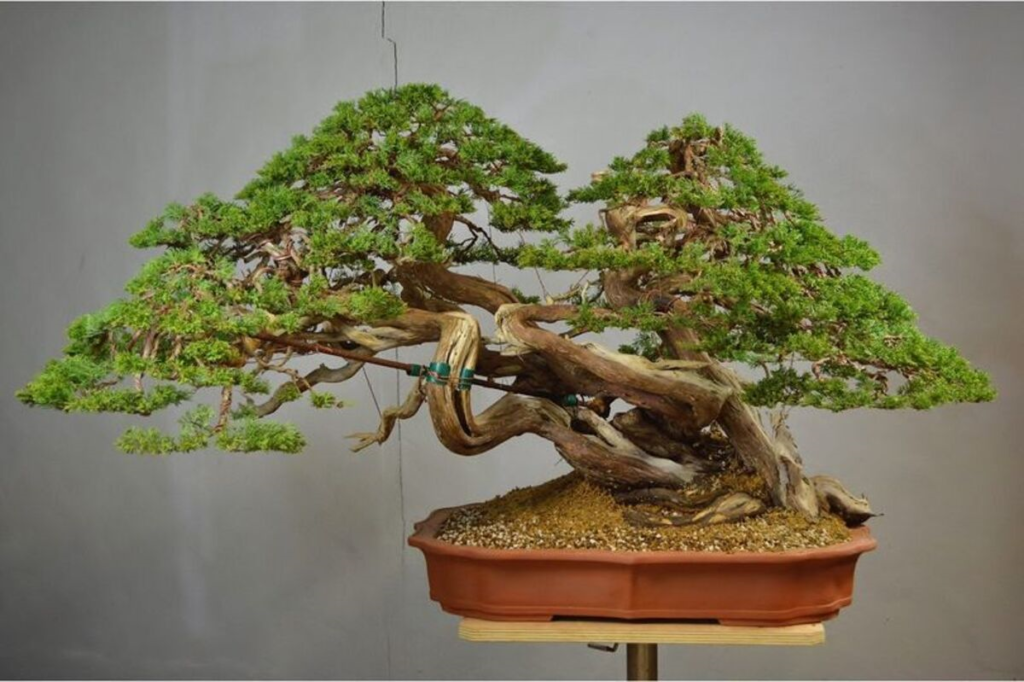
How to Care for and Maintain Sabina Juniper Bonsai
The care and maintenance of a Sabina Juniper bonsai necessitates regular attention to its particular requirements. By adhering to these guidelines, you can assure your bonsai tree’s health and vitality:
- Watering: Proper watering is crucial for the well-being of your Sabina Juniper Bonsai. Water the tree thoroughly when the top inch of the soil feels slightly dry. Avoid overwatering, as it can lead to root rot. Ensure that the bonsai pot has drainage holes to allow excess water to escape.
- Sunlight: Sabina Juniper Bonsai thrives in full sun or partial shade. Place your bonsai in a location that receives at least 6 hours of sunlight each day. If you are keeping it indoors, provide it with bright, indirect light near a window. Rotate the bonsai periodically to ensure even exposure to sunlight.
- Fertilization: Feed your Sabina Juniper Bonsai with a balanced, slow-release bonsai fertilizer during the growing season (spring to early autumn). Follow the instructions provided by the manufacturer for the appropriate dosage and frequency. Refrain from fertilizing during the winter or periods of dormancy.
- Pruning: Regular pruning helps maintain the desired shape and size of your Sabina Juniper Bonsai. Trim back new growth to maintain the tree’s form and encourage branching. Remove any dead, damaged, or diseased branches. Pruning can be done throughout the year, but it is best to avoid major pruning during the winter.
- Wiring: Wiring is often used to shape the branches of a Sabina Juniper Bonsai. Use bonsai wire to gently guide the branches into the desired position. Be careful not to apply excessive pressure that may damage or break the branches. Monitor the growth regularly and adjust or remove the wire as needed to prevent it from cutting into the tree’s bark.
- Repotting: Sabina Juniper Bonsai should be repotted every 2-3 years, typically in the early spring before new growth emerges. Trim the roots and refresh the soil to provide optimal growing conditions. Repotting helps prevent the tree from becoming root-bound and promotes healthy root development.
- Protection from Extreme Conditions: While Sabina Juniper Bonsai is hardy, it is still important to protect it from extreme weather conditions. Provide shelter or bring the bonsai indoors during periods of severe heat, frost, or strong winds. This will help protect the tree from stress and potential damage.
- Pest and Disease Control: Regularly inspect your Sabina Juniper Bonsai for common pests such as spider mites, aphids, or scale insects. Treat any infestations promptly with appropriate insecticides or organic pest control methods. Ensure good airflow around the tree to minimize the risk of fungal diseases.
- Observing and Adjusting: Regularly observe your Sabina Juniper Bonsai for any signs of stress, such as wilting leaves or discoloration. Adjust your care routine as needed based on the tree’s response. Each bonsai is unique, and understanding its specific needs will help you provide the best care.
By following these care guidelines, you can maintain the health and beauty of your Sabina Juniper Bonsai for years to come. Remember, consistent care and attention are key to the success of your bonsai tree.
Sabina Juniper Bonsai Care Sheet
| Aspect | Care Tips |
| Watering | Water thoroughly when the top inch of soil is dry. |
| Avoid overwatering to prevent root rot. | |
| Sunlight | Place in full sun to partial shade. |
| Provide bright, indirect light indoors. | |
| Fertilization | Use balanced, slow-release bonsai fertilizer. |
| Apply during the growing season, following instructions. | |
| Pruning | Regularly prune to maintain shape and encourage branching. |
| Remove dead, damaged, or diseased branches. | |
| Wiring | Use bonsai wire to shape branches as needed. |
| Monitor growth and adjust or remove wire accordingly. | |
| Repotting | Repot every 2-3 years, before new growth appears. |
| Trim roots and refresh soil for optimal conditions. | |
| Humidity | Sabina Juniper prefers normal to dry humidity levels. |
| Pest and Disease Control | Regularly inspect for pests like mites or scale insects. |
| Treat infestations promptly with appropriate methods. | |
| Regular Maintenance | Observe the tree for signs of stress or abnormalities. |
| Adjust care routine based on the tree’s response. |
Remember to closely observe your Sabina Juniper Bonsai and adjust care practices accordingly. Each bonsai may have specific needs and preferences, so paying attention to its response will help you provide the best care. Regular maintenance and attention to detail will ensure the health and vitality of your Sabina Juniper Bonsai.
Conclusion:
Sabina Juniper Bonsai is a captivating and resilient tree that offers bonsai enthusiasts a rewarding experience. By understanding its unique characteristics, providing appropriate care, and applying styling techniques, you can create a stunning Sabina Juniper Bonsai that brings joy and beauty to your bonsai collection. Enjoy the journey of nurturing this remarkable bonsai variety, and let its timeless elegance enrich your bonsai gardening endeavors.
FAQ:
Q: What is Sabina Juniper Bonsai?
A: Sabina Juniper Bonsai is a bonsai tree species that belongs to the Juniperus Sabina family. It is known for its twisted trunks, gnarled branches, and delicate foliage.
Q: How tall does a Sabina Juniper Bonsai grow?
A: Sabina Juniper The height of a bonsai can vary based on the cultivar and the artist’s choices. It may grow from a few inches to many feet tall.
Q: Is Sabina Juniper Bonsai an indoor or outdoor tree?
A: Sabina Juniper Bonsai is primarily an outdoor tree. It requires ample sunlight and fresh air to thrive. However, it can be kept indoors for short periods with proper care and adequate sunlight.
Q: How often should I water Sabina Juniper Bonsai?
A: Sabina Juniper Bonsai should be watered when the top inch of soil feels slightly dry. The frequency of watering may vary depending on factors like climate, pot size, and the tree’s health.
Q: Can I shape the branches of the Sabina Juniper Bonsai?
A: Yes, the branches of Sabina Juniper Bonsai can be shaped through pruning and wiring techniques. Pruning helps maintain the desired shape, while wiring gently guides the branches into the desired position.
Q: How often should I fertilize Sabina Juniper Bonsai?
A: Sabina Juniper Bonsai should be fertilized during the growing season, typically from spring to early autumn. A balanced, slow-release bonsai fertilizer can be used according to the instructions provided by the manufacturer.
Q: When should I repot Sabina Juniper Bonsai?
A: Sabina Juniper Bonsai should be repotted every 2–3 years, usually in the early spring before new growth emerges. Repotting helps prevent the tree from becoming root-bound and promotes healthy root development.
Q: What pests and diseases should I watch out for with Sabina Juniper Bonsai?
A: Sabina Juniper Bonsai can be susceptible to pests such as spider mites, aphids, and scale insects. Regular inspections should be carried out, and appropriate insecticides or organic pest control methods can be used to treat infestations.
Q: How do I protect Sabina Juniper Bonsai from extreme weather conditions?
A: Sabina Juniper Bonsai should be protected from extreme heat, frost, or strong winds. Providing shelter or bringing the bonsai indoors during severe weather can help safeguard the tree.
Also Read:




